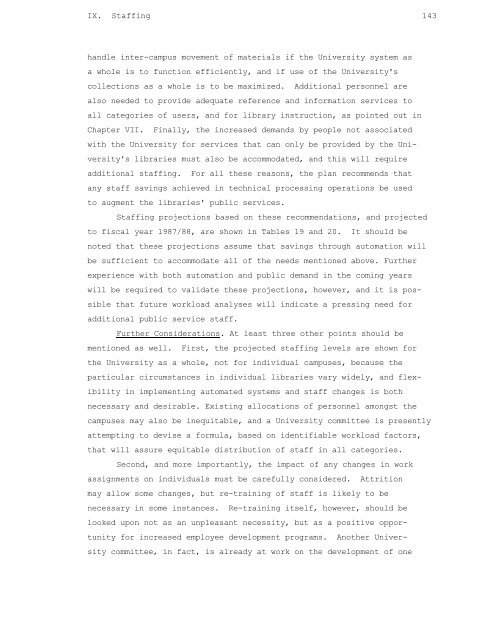The University of California Libraries: A Plan for Development (1977)
The University of California Libraries: A Plan for Development (1977)
The University of California Libraries: A Plan for Development (1977)
You also want an ePaper? Increase the reach of your titles
YUMPU automatically turns print PDFs into web optimized ePapers that Google loves.
IX. Staffing 143<br />
handle inter-campus movement <strong>of</strong> materials if the <strong>University</strong> system as<br />
a whole is to function efficiently, and if use <strong>of</strong> the <strong>University</strong>'s<br />
collections as a whole is to be maximized. Additional personnel are<br />
also needed to provide adequate reference and in<strong>for</strong>mation services to<br />
all categories <strong>of</strong> users, and <strong>for</strong> library instruction, as pointed out in<br />
Chapter VII. Finally, the increased demands by people not associated<br />
with the <strong>University</strong> <strong>for</strong> services that can only be provided by the <strong>University</strong>'s<br />
libraries must also be accommodated, and this will require<br />
additional staffing. For all these reasons, the plan recommends that<br />
any staff savings achieved in technical processing operations be used<br />
to augment the libraries' public services.<br />
Staffing projections based on these recommendations, and projected<br />
to fiscal year 1987/88, are shown in Tables 19 and 20. It should be<br />
noted that these projections assume that savings through automation will<br />
be sufficient to accommodate all <strong>of</strong> the needs mentioned above. Further<br />
experience with both automation and public demand in the coming years<br />
will be required to validate these projections, however, and it is possible<br />
that future workload analyses will indicate a pressing need <strong>for</strong><br />
additional public service staff.<br />
Further Considerations. At least three other points should be<br />
mentioned as well. First, the projected staffing levels are shown <strong>for</strong><br />
the <strong>University</strong> as a whole, not <strong>for</strong> individual campuses, because the<br />
particular circumstances in individual libraries vary widely, and flexibility<br />
in implementing automated systems and staff changes is both<br />
necessary and desirable. Existing allocations <strong>of</strong> personnel amongst the<br />
campuses may also be inequitable, and a <strong>University</strong> committee is presently<br />
attempting to devise a <strong>for</strong>mula, based on identifiable workload factors,<br />
that will assure equitable distribution <strong>of</strong> staff in all categories.<br />
Second, and more importantly, the impact <strong>of</strong> any changes in work<br />
assignments on individuals must be carefully considered. Attrition<br />
may allow some changes, but re-training <strong>of</strong> staff is likely to be<br />
necessary in some instances. Re-training itself, however, should be<br />
looked upon not as an unpleasant necessity, but as a positive opportunity<br />
<strong>for</strong> increased employee development programs. Another <strong>University</strong><br />
committee, in fact, is already at work on the development <strong>of</strong> one
















